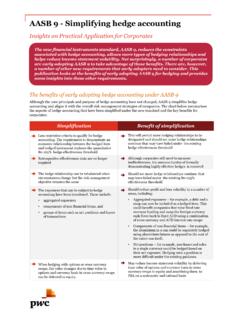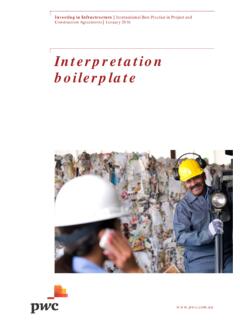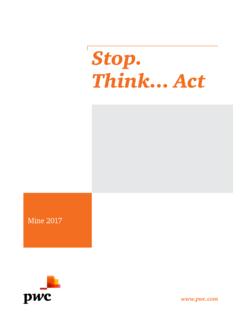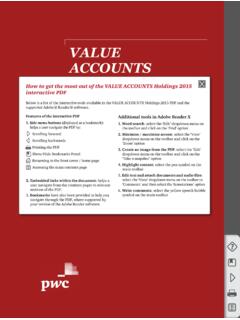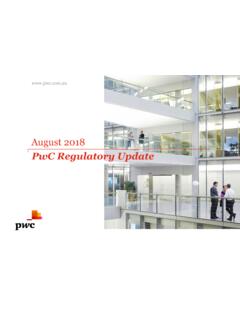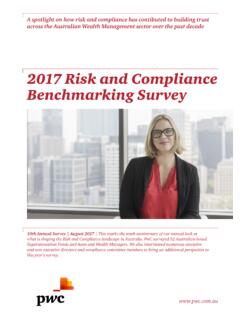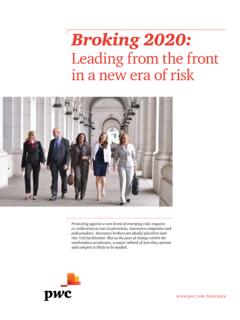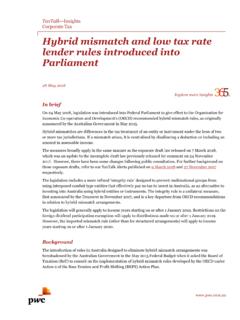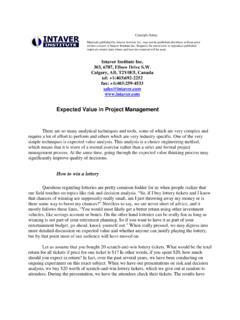Transcription of Tips and tricks - PwC
1 Tax effect accounting tips and tricks Erin Craike, Tobias Dowidat What is the issue? The difficult area of tax effect accounting is back in the spotlight, with ASIC announcing it will focus on tax effect accounting in its review of December financial reports. Tax effect accounting can be a maze for financial report preparers. It s complicated; it requires input from tax experts, and the laws that underpin tax exposures are constantly changing. So how do you get through the maze? In our experience, there are three main obstacles you need to navigate. Know your bases Remember that the accounting standard requires a balance sheet approach to determining deferred tax.
2 The old P&L approach used prior to the adoption of IFRS is no longer acceptable. The accounting and tax bases of each asset and liability are used to determine the temporary differences on which deferred taxes may be recognised. The accounting and tax bases will usually differ from each other, because of the complex and dynamic nature of tax laws and accounting rules. For example, a financial instrument may be considered equity for tax purposes but a liability for accounting purposes. Similarly, capital gains tax may apply to most assets of a particular class, but vary according to when the asset was purchased.
3 Tax rules may require an asset to be depreciated at a different rate to that required by the accounting standards. It s important that the tax base reflect how management expects to realise the asset and settle a liability and that the accounting base be relevant to the entity s or group s financial statement. The short version is: tax is complex, and financial report preparers should never assume they have all the information they need without involving their tax colleagues. Tax expertise is essential, as is an understanding of how management intends to deal with assets and liabilities. So, for a smooth tax accounting process, we recommend the following steps: Together with your tax colleagues, consider how management intends to realise assets and settle liabilities.
4 Work with your tax colleagues to make sure tax bases for all assets are clearly understood. Ensure the appropriate accounting base is used for the set of accounts being prepared ( , entity, group). Calculate the temporary differences towards the end of the reporting process to avoid the need to recalculate them. Watch for amounts booked through reserves. Tax accounting should follow the accounting treatment of the underlying line item. Accounting pitfalls Some of the requirements of the accounting literature cause particular issues in practice. Keep your eye on the following. Exceptions: in some circumstances deferred tax does not need to be recognised on certain assets and liabilities, such as investments in subsidiaries or acquisitions of assets.
5 It is important that preparers understand February 2014 . This content is for general information purposes only, and should not be used as a substitute for consultation with professional advisors. 2014 PwC. All rights reserved. PwC refers to the PwC network and/or one or more of its member firms, each of which is a separate legal entity. Please see for further details. these, and how to apply the exception to the original temporary differences and later changes. Deferred tax generally must be recognised for equity method investments and joint arrangements. Understanding the tax implications of distributions from these investments is often important.
6 Consolidation: differences in accounting values, tax bases or availability of exceptions mean that tax balances in the consolidated accounts will often be different from single entity accounts. For example, in a business combination, deferred taxes in the consolidated accounts must be recognised based on the accounting fair value and the tax base relevant to the consolidated group. In the subsidiary accounts, deferred tax would continue to be recognised on the existing accounting carrying value and may not be recognised at all due to the availability of an exception. Tax consolidation requirements must also be considered, for example, understanding the tax funding arrangements and determining the appropriate policy for allocating taxes among the group.
7 Rate reconciliation: companies must disclose a reconciliation of the relationship between tax expense (or income) and accounting profit, known as the tax reconciliation. Examples of reconciling items may include deviations from the average group tax rate, tax free income, non-deductible expenses ( impairments or share-based payments) or certain effects from tax losses. This can be very complex and preparers are sometimes tempted to bracket items into the others bucket to avoid having to reconcile in detail. As a result, this category is often the subject of discussions between the preparer, the auditor and the regulator.
8 Unfortunately, there is no easy way out: preparers need to understand the reconciliation and must be able to explain and justify the composition of the others item. Specific guidance: there are some pockets of tax accounting that have specific, detailed guidance, in particular around share-based payments, financial instruments, business combinations and government grants. Preparers should make sure they are aware of these areas and, if they need to apply them, come to grips with the detailed requirements rather than simply relying on the broad principles of tax accounting. Changes to tax laws: tax laws change continuously.
9 Tax advice should be sought at each reporting period to understand those changes and any impacts: including the impact of any changes that have been substantively enacted, as this will also need to be reflected in the accounts. Judgement areas There are some areas that are particularly likely to require significant judgement in the application of tax accounting. Recoverability: for a deferred tax asset to be recognised, recovery of that asset must be probable. Where a company has a history of tax losses, this becomes particularly critical. Preparers need to consider the expiration date of the tax losses in the relevant jurisdiction and what evidence is available to support the likelihood of future taxable profits.
10 Disclosure of significant judgements or estimates, and the evidence used to make them, will usually be required. Uncertain tax positions: preparers must evaluate whether a liability should be recognised for any uncertain tax positions that are likely to result in tax payment, as well as any probable penalties and interest. Disclosure of such judgements and estimates may also be needed. Significant tax expertise is generally required to determine what will be This content is for general information purposes only, and should not be used as a substitute for consultation with professional advisors. 2014 PwC.
